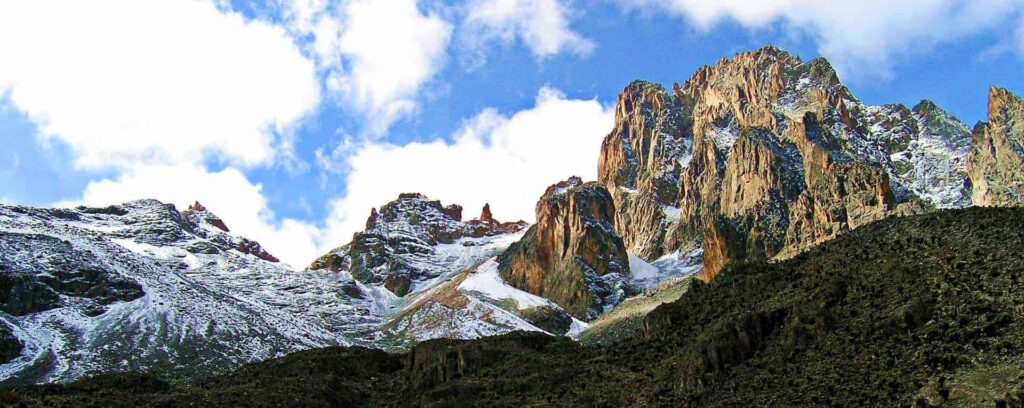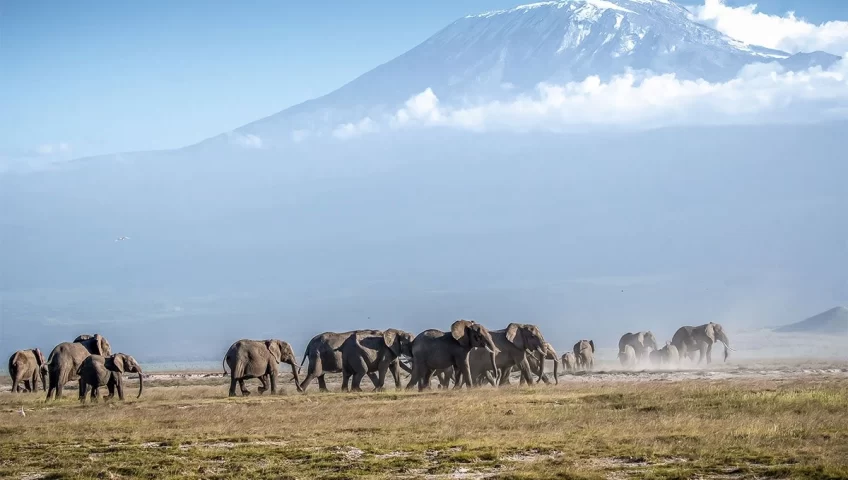After Mount Kilimanjaro, Mount Kenya National Park is the second-highest mountain in Africa. It was designated as a protected area in 1949 and is known by the moniker “Come touch the sky” due to its peak’s height of 5,199 meters. The 715 square meter protected area include the Kenyan mountain, the local fauna, and the forest reserve. The various vegetation zoning zones serve as excellent habitats for wildlife, particularly mammals and birds.
The mountain serves as a water catchment area for the park, collecting water from melting glaciers and natural springs. Rare and endangered species of wildlife can be found in the park. The plains wildlife and vegetation that resembles alpine vegetation have adapted to the high altitude. While on their Kenya Wildlife excursions, the visitors take pleasure in trekking the mountain, camping, and caves alongside the mountain’s rough glacier.
Before it was designated as a national park that included Mt. Kenya and the forest reserve, the park was initially the forest reserve. Just one year after being named a UNESCO World Heritage Site in 1977, the entire region was then classified as a UNESCO Biosphere Reserve in 1978. The Kenyan government primarily intended to conserve the park’s biodiversity, natural picturesque views, and most significantly, the water source that was so crucial to the community in the area. These goals led to the park’s gazetting.
How to get to Mount Kenya National Park
Using road transportation, it is extremely simple to travel the 175 kilometers from Nairobi to the Mount Kenya National Park. The Nanyuki-Isiolo Road is used by several public taxis and shuttles that travel daily to the Mt. Kenya region. One can cross through Naro Moru by way of Sirimon Track or Nyeri-Nanyuki route.
The park is also accessible via Chogoria on the Embu-Meru, which is located 150 kilometers north of Nairobi, the country’s capital. You can arrange for a private tour operator driver-guide to pick you up from your hotel in Nairobi. If local operators organize it, it will be simple for you even though it is expensive and offers numerous benefits to the guest, including safety and on-time arrival. If one wants to successfully arrive to the park or be dropped off close to the park gates when traveling by public transportation, one must be aware that there are often three roads that are highly suggested to utilize.
If using public transportation, the cost ranges from 500 to 800 Kenyan Shillings and dumps you off on the main road. The cost of a special hiring to get you to the park gates today ranges from 2000 to 8000 Kenyan shillings, depending on how far the first taxi left you. In the Mount Kenya National Park, there are four gates: the Kamweti, Marania, Burguret, and Themwe gates.
Domestic aircraft can also get you to the park, dropping you off at Nanyuki airfield, which is the closest airport. Your driver-guide will be there to welcome you at the airport, take you to the park gate so you can get cleared, and then start the day’s climb. Depending on your level of physical fitness, 3 to 4 days of hiking are recommended.
Vegetation of Mount Kenya National park
The Mount Kenya National Park’s vegetation is diversified because of the park’s various altitudes, which results in shifting vegetation zoning. The park’s vegetation is separated into various zones that alter as the altitude changes. Depending on how well each plant can acclimatize to the altitude, a different plant dominates each Zone. The majority of plant species at the Mountain have both their English names and the native Kikuyu and Embu names, which is unusual.

The Indian Ocean, which extends from the east to the south-east, is the source of the park’s damp weather. While the park’s surroundings are generally level and are covered by open savannahs and receive little rainfall, the hills that receive heavy amounts of rain are covered by dense bamboo growth. The native Kikuyu have now converted the open savannah to agricultural land. From broad savannah grassland through montane forest to bamboo and the Afro-alpine zone, the vegetation is ranked.
Arrangement of the vegetation Zone in Mt Kenya
Cultivated Zone
The Kikuyu converted this into agricultural land, but it is still covered by the open savannah grassland.
Montane Forest
As one ascends to an altitude of 2000 meters, they reach a montane forest that is dominated by Ocotea usambarensis. This comes after the grassland.
Bamboo Zone
This is a confined location with heavy rainfall that is located in the center of a mountain covered with bamboo trees.
Timberline Forest
African rosewood dominates this area, which is located between 3,000 and 3,500 meters above sea level.
Heathland and Chaparral
This can be found at an altitude of 3,200 to 3,800 meters. While the Chaparral can be found in the mountain’s drier regions, it primarily inhabits the area where the mountain is wettest. Erica predominates in heathland, while African sage does so in chaparral.
Afro-alpine Zone
This mountain’s second-to-last vegetation zone spans the elevation range of 3500 meters to 4500 meters. Dendrosenecio Keniensis and Dendrosenecio keniodendron, two enormous species, dominate it.
Nival zone:
This is the last zone with glacier and it is above 4500 meters.
Mount Kenya National Park’s attractions
Wildlife
More species can be seen in Mount Kenya National Park, including large African Forest Elephants, Cape Buffaloes, monkeys, leopards, Dik-diks, and Forest Hogs among many others. Over 130 different bird species, predominantly woodland birds, can be found in the park.
Mont KenyaThe park’s main draw is the second-highest mountain in Africa. The mountain takes up approximately half of the park. The mountain may be climbed in 3 to 5 days, however the technical climbers usually reach the top first.
Mount Kenya National Park activities
The park is home to a number of amusing activities that enhance visitors’ trips to Africa. One can experience the actual wilderness of Africa by taking a safari to Mount Kenya National Park.
Many people are misled by the park’s name into assuming that it is primarily used for hiking, which is incorrect. As I mention in this essay, there are a number of things you may do in the park.
Hiking
There are seven distinct paths up the mountain, and this is the main activity there. Naro Moru is the simplest and most well-liked of the seven paths. Sirimon, Chogoria, Batian, Nelion, Timau Route, and Burguret Route are more routes.
Game viewing
Although the park is known for its mountains, it is also home to a variety of animals, including mammals like forest elephants, buffalo, and others. On the Keny safari vans, the passengers have pleasure in viewing game. They occasionally get to witness leopards and forest hogs.
Birding
More than 130 different bird species call the park home, the majority of which are forest birds and only a few of which are open savannah birds. Although they can be taken at any time of year, birding safaris are best taken in the rainy season when the birds are nesting and reproducing.
Scenic views
Enjoy the sightseeing and beautiful mountain vistas, especially if you are a trekker rather than a hiker who can’t make it to the summit. As part of the Kenya Safari Tour, seeing the caves is also possible at the park, which is a wonderful experience.
Just a few meters from the Equator, the Mount Kenya National Park, which is dominated by Africa’s second-highest mountain, offers beautiful scenery. visiting the Kikuyu’s ancient divinity, Ngai. The residents still keep their doors wide and face the mountain because they think they receive a blessing from it. For religious ceremonies and other customs, the Kikuyu travel to the mountain’s slopes.

